Caspase-3 Antibody (31A1067) - (Pro and Active) - BSA Free
Novus Biologicals, part of Bio-Techne | Catalog # NB100-56708

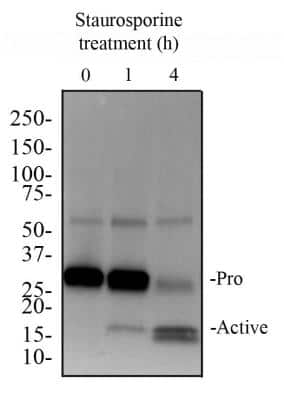
Conjugate
Catalog #
Forumulation
Catalog #
Key Product Details
Validated by
Biological Validation
Species Reactivity
Validated:
Human, Mouse, Rat, Porcine, Chicken, Chinese Hamster, Mammal
Cited:
Human, Mouse, Rat, Avian - Chicken, Hamster - Cricetulus (Chinese Hamster), Mammal, Rabbit
Applications
Validated:
CyTOF-ready, Electron Microscopy, Flow Cytometry, Hematoxylin and Eosin Stain, Immunoblotting, Immunocytochemistry/ Immunofluorescence, Immunohistochemistry, Immunohistochemistry Free-Floating, Immunohistochemistry-Frozen, Immunohistochemistry-Paraffin, Knockdown Validated, Knockout Validated, Simple Western, Western Blot
Cited:
Block/Neutralize, Electron Microscopy, Flow Cytometry, Hematoxylin and Eosin Stain, IF/IHC, Immunoblotting, Immunocytochemistry/ Immunofluorescence, Immunohistochemistry, Immunohistochemistry Free-Floating, Immunohistochemistry-Frozen, Immunohistochemistry-Paraffin, Knockdown Validated, Simple Western, Western Blot
Label
Unconjugated
Antibody Source
Monoclonal Mouse IgG1 kappa Clone # 31A1067
Format
BSA Free
Concentration
1 mg/ml
Product Specifications
Immunogen
This Caspase-3 Antibody (31A1067) - (Pro and Active) was developed against full-length recombinant human caspase-3 protein.
Reactivity Notes
Chicken reactivity reported in scientific literature (PMID: 30298003).
Specificity
The antibody detects both pro Caspase-3 (~32 kDa) and the large subunit of the active/cleaved form (~14-21 kDa) of Caspase-3.
Clonality
Monoclonal
Host
Mouse
Isotype
IgG1 kappa
Theoretical MW
31.7 kDa.
Disclaimer note: The observed molecular weight of the protein may vary from the listed predicted molecular weight due to post translational modifications, post translation cleavages, relative charges, and other experimental factors.
Disclaimer note: The observed molecular weight of the protein may vary from the listed predicted molecular weight due to post translational modifications, post translation cleavages, relative charges, and other experimental factors.
Scientific Data Images for Caspase-3 Antibody (31A1067) - (Pro and Active) - BSA Free
Western Blot Detection of Pro and Active Caspase-3 in Whole Cell Protein From Treated Jurkat Cells
Image of Caspase-3 Antibody (31A1067) - (Pro and Active). Whole cell protein from Jurkat cells treated with and without 2 uM staurosporine as indicated was separated on a 4-15% gel by SDS-PAGE, transferred to 0.2 um PVDF membrane and blocked in 5% non-fat milk in TBST. The membrane was probed with 5 ug/ml anti-Caspase 3 in 1% milk, and detected with an anti-mouse HRP secondary antibody using a Femto sensitivity chemiluminescence reagent. Note the detection of both pro-caspase 3 at 35 kDa and the cleaved active caspase 3 at 15-17 kDa.Immunohistochemical Staining of Caspase-3 in Paraffin Embedded Human Spleen
Tissue section of human spleen using 1:200 dilution of Caspase-3 antibody (clone 31A1067). The staining was developed with HRP labeled anti-mouse IgG secondary antibody and DAB reagent, and nuclei of cells were counter-stained with hematoxylin. This Caspase 3 antibody generated primarily a specific cytoplasmic staining in a subset of spleenocytes with some nuclear signal in a few cells.Detection of Caspase-3 in HeLa Cell Lysate by Simple Western
Simple Western lane view shows a specific band for Caspase-3 Antibody (31A1067) - (Pro and Active) in 0.1 mg/ml of HeLa lysate. This experiment was performed under reducing conditions using the 12-230kDa separation system.Applications for Caspase-3 Antibody (31A1067) - (Pro and Active) - BSA Free
Application
Recommended Usage
Electron Microscopy
reported in scientific literature (PMID 27450722)
Flow Cytometry
reported in scientific literature (PMID 27429862)
Hematoxylin and Eosin Stain
reported in scientific literature (PMID 28186963)
Immunoblotting
reported in scientific literature (PMID 28500555)
Immunocytochemistry/ Immunofluorescence
reported in scientific literature (PMID 23840553)
Immunohistochemistry
1:10 - 1:500
Immunohistochemistry Free-Floating
reported in scientific literature (PMID 31771656)
Immunohistochemistry-Frozen
1:10 - 1:500. Use reported by customer review
Immunohistochemistry-Paraffin
1:10 - 1:500. Use reported in scientific literature (PMID 28500555)
Knockdown Validated
reported in scientific literature (PMID 32867814)
Simple Western
1:50
Western Blot
1 - 5 ug/ml
Application Notes
The large subunit of the cleaved form may appear as one or two or even as a stack of bands depending on the presence or absence of the Caspase-3 pro-domain. It is highly recommended that a maximum sensitivity ECL substrate (Femto sensitive) be used for efficient detection of this antibody in Western blot applications. In Simple Western only 10 - 15 ul of the recommended dilution is used per data point.
See Simple Western Antibody Database for Simple Western validation: Tested in Ovaries, separated by Size, antibody dilution of 1:200, apparent MW was 38,32,23 kDa. Separated by Size-Wes, Sally Sue/Peggy Sue. This antibody is CyTOF ready.
See Simple Western Antibody Database for Simple Western validation: Tested in Ovaries, separated by Size, antibody dilution of 1:200, apparent MW was 38,32,23 kDa. Separated by Size-Wes, Sally Sue/Peggy Sue. This antibody is CyTOF ready.
Reviewed Applications
Read 3 reviews rated 4.7 using NB100-56708 in the following applications:
Formulation, Preparation, and Storage
Purification
Protein G purified
Formulation
PBS
Format
BSA Free
Preservative
0.05% Sodium Azide
Concentration
1 mg/ml
Shipping
The product is shipped with polar packs. Upon receipt, store it immediately at the temperature recommended below.
Stability & Storage
Store at 4C short term. Aliquot and store at -20C long term. Avoid freeze-thaw cycles.
Background: Caspase-3
References
1.Mu, N., Lei, Y., Wang, Y., Wang, Y., Duan, Q., Ma, G., . . . Su, L. (2019). Inhibition of SIRT1/2 upregulates HSPA5 acetylation and induces pro-survival autophagy via ATF4-DDIT4-mTORC1 axis in human lung cancer cells. Apoptosis, 24(9-10), 798-811. doi:10.1007/s10495-019-01559-3
2.Sun, C. M., Enkhjargal, B., Reis, C., Zhou, K. R., Xie, Z. Y., Wu, L. Y., . . . Zhang, J. H. (2019). Osteopontin attenuates early brain injury through regulating autophagy-apoptosis interaction after subarachnoid hemorrhage in rats. CNS Neurosci Ther, 25(10), 1162-1172. doi:10.1111/cns.13199
3.Louneva, N., Cohen, J. W., Han, L. Y., Talbot, K., Wilson, R. S., Bennett, D. A., . . . Arnold, S. E. (2008). Caspase-3 is enriched in postsynaptic densities and increased in Alzheimer's disease. Am J Pathol, 173(5), 1488-1495. doi:10.2353/ajpath.2008.080434
Alternate Names
Apopain, CASP3, Caspase3, CPP32, LICE-1, YAMA
Gene Symbol
CASP3
Additional Caspase-3 Products
Product Documents for Caspase-3 Antibody (31A1067) - (Pro and Active) - BSA Free
Product Specific Notices for Caspase-3 Antibody (31A1067) - (Pro and Active) - BSA Free
This product is for research use only and is not approved for use in humans or in clinical diagnosis. Primary Antibodies are guaranteed for 1 year from date of receipt.
Loading...
Loading...
Loading...
Loading...
Loading...
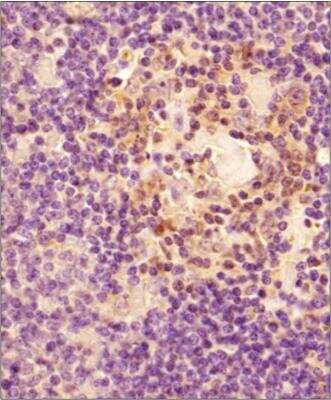

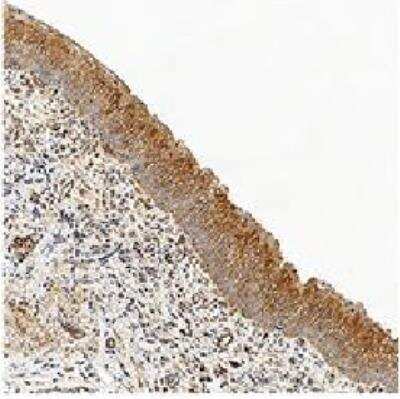
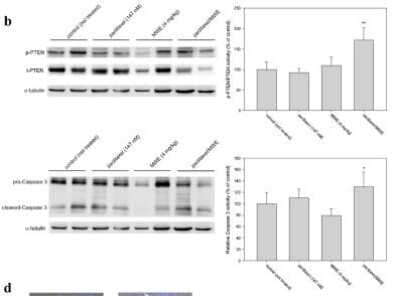
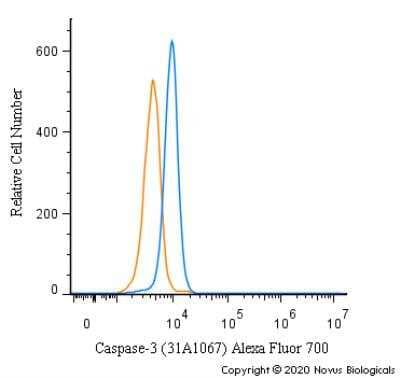
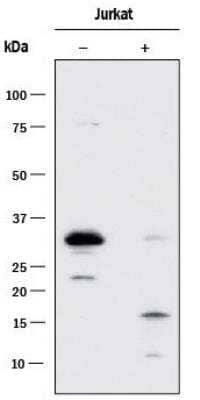
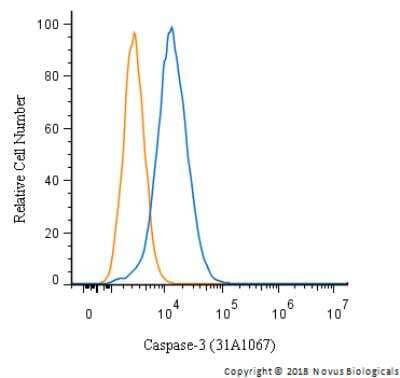
![Western Blot: Mouse Monoclonal Caspase-3 Antibody (31A1067) - (Pro and Active) [IMGENEX: IMG-144A] [NB100-56708] - Caspase-3 Antibody (31A1067) - (Pro and Active) - BSA Free](https://resources.bio-techne.com/images/products/antibody/nb100-56708_mouse-monoclonal-caspase-3-antibody-31a1067-pro-and-active-imgenex-img-144a-western-blot-3112024145834..png)
![Immunocytochemistry/ Immunofluorescence: Caspase-3 Antibody (31A1067) - (Pro and Active) - BSA Free [NB100-56708] - Caspase-3 Antibody (31A1067) - (Pro and Active) - BSA Free](https://resources.bio-techne.com/images/products/nb100-56708_mouse-monoclonal-caspase-3-antibody-31a1067-pro-and-active-310202415175231.jpg)
![Western Blot: Caspase-3 Antibody (31A1067) - (Pro and Active) - BSA Free [NB100-56708] - Caspase-3 Antibody (31A1067) - (Pro and Active) - BSA Free](https://resources.bio-techne.com/images/products/nb100-56708_mouse-monoclonal-caspase-3-antibody-31a1067-pro-and-active-310202415175219.jpg)
![Western Blot: Caspase-3 Antibody (31A1067) - (Pro and Active) - BSA Free [NB100-56708] - Caspase-3 Antibody (31A1067) - (Pro and Active) - BSA Free](https://resources.bio-techne.com/images/products/nb100-56708_mouse-monoclonal-caspase-3-antibody-31a1067-pro-and-active-310202415371987.jpg)
![Immunocytochemistry/ Immunofluorescence: Caspase-3 Antibody (31A1067) - (Pro and Active) - BSA Free [NB100-56708] - Caspase-3 Antibody (31A1067) - (Pro and Active) - BSA Free](https://resources.bio-techne.com/images/products/nb100-56708_mouse-monoclonal-caspase-3-antibody-31a1067-pro-and-active-31020241612697.jpg)
![Western Blot: Caspase-3 Antibody (31A1067) - (Pro and Active) - BSA Free [NB100-56708] - Caspase-3 Antibody (31A1067) - (Pro and Active) - BSA Free](https://resources.bio-techne.com/images/products/nb100-56708_mouse-monoclonal-caspase-3-antibody-31a1067-pro-and-active-3102024155528.jpg)
![Immunocytochemistry/ Immunofluorescence: Caspase-3 Antibody (31A1067) - (Pro and Active) - BSA Free [NB100-56708] - Caspase-3 Antibody (31A1067) - (Pro and Active) - BSA Free](https://resources.bio-techne.com/images/products/nb100-56708_mouse-monoclonal-caspase-3-antibody-31a1067-pro-and-active-3102024155450.jpg)
![Western Blot: Caspase-3 Antibody (31A1067) - (Pro and Active) - BSA Free [NB100-56708] - Caspase-3 Antibody (31A1067) - (Pro and Active) - BSA Free](https://resources.bio-techne.com/images/products/nb100-56708_mouse-monoclonal-caspase-3-antibody-31a1067-pro-and-active-3102024155373.jpg)
![Western Blot: Caspase-3 Antibody (31A1067) - (Pro and Active) - BSA Free [NB100-56708] - Caspase-3 Antibody (31A1067) - (Pro and Active) - BSA Free](https://resources.bio-techne.com/images/products/nb100-56708_mouse-monoclonal-caspase-3-antibody-31a1067-pro-and-active-31020241552392.jpg)
![Western Blot: Caspase-3 Antibody (31A1067) - (Pro and Active) - BSA Free [NB100-56708] - Caspase-3 Antibody (31A1067) - (Pro and Active) - BSA Free](https://resources.bio-techne.com/images/products/nb100-56708_mouse-monoclonal-caspase-3-antibody-31a1067-pro-and-active-31020241612680.jpg)
![Western Blot: Caspase-3 Antibody (31A1067) - (Pro and Active) - BSA Free [NB100-56708] - Caspase-3 Antibody (31A1067) - (Pro and Active) - BSA Free](https://resources.bio-techne.com/images/products/nb100-56708_mouse-monoclonal-caspase-3-antibody-31a1067-pro-and-active-31020241682182.jpg)